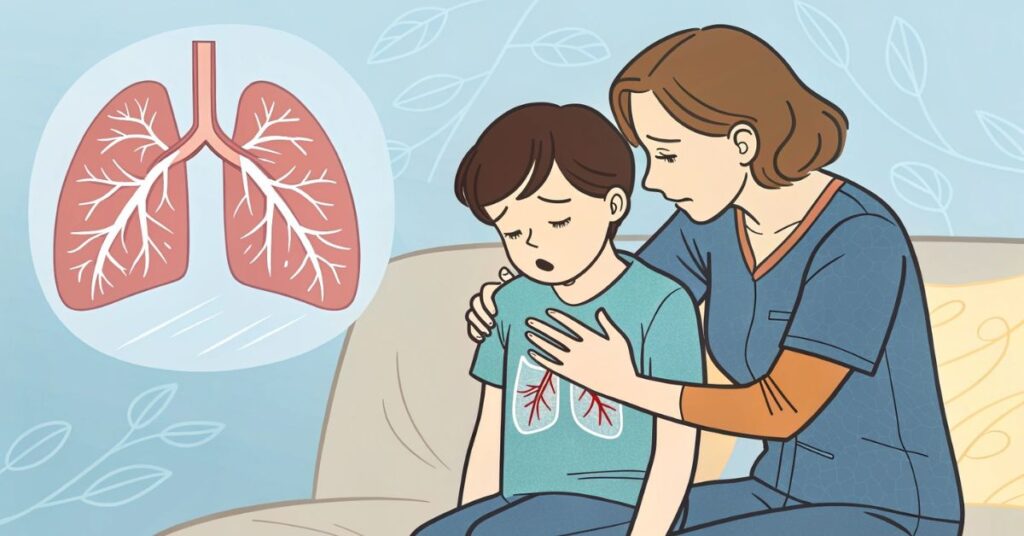Asthma is one of the most common chronic conditions affecting children in the United States. It can cause breathing difficulties, coughing, and wheezing, making everyday activities challenging for kids. If left untreated, asthma can lead to severe complications. However, with proper care, children with asthma can live healthy and active lives.
This guide covers everything parents and caregivers need to know about symptoms and treatment of asthma in children. You will learn how to recognize the warning signs, explore treatment options, and find ways to help your child manage asthma effectively.
What Is Asthma?
Asthma is a long-term lung disease that causes inflammation and narrowing of the airways. This makes it hard for children to breathe, leading to symptoms like wheezing, coughing, and shortness of breath. Asthma symptoms can come and go, often triggered by allergens, infections, or physical activity.
How Common Is Asthma in Children?
According to the Centers for Disease Control and Prevention (CDC), around 6 million children in the U.S. have asthma. It is one of the leading causes of missed school days and emergency room visits.
Common Symptoms of Asthma in Children
1. Frequent Coughing
- Coughing that worsens at night or early in the morning.
- Often triggered by cold air, exercise, or allergens.
2. Wheezing
- A high-pitched whistling sound when breathing out.
- More noticeable when your child is physically active or has a cold.

3. Shortness of Breath
- Your child may struggle to breathe, especially during physical activities.
- In severe cases, they might feel like they “can’t get enough air.”
4. Chest Tightness or Pain
- Complaints of chest discomfort or pain.
- Younger children may describe it as a “sore tummy.”
5. Fatigue
- Feeling unusually tired, especially after minor physical exertion.
- Difficulty keeping up with other children during play.
6. Difficulty Sleeping
- Coughing and wheezing can interrupt sleep.
- Your child may wake up frequently at night due to breathing issues.
7. Rapid Breathing
- Faster-than-normal breathing, even while at rest.
- Can be a sign of worsening asthma symptoms.
What Causes Asthma in Children?
There is no single cause of asthma, but some factors can increase the risk.
- Genetics: If one or both parents have asthma, their child has a higher chance of developing it due to inherited traits.
- Allergies: Common allergens like dust mites, pet dander, mold, and pollen can irritate the airways and trigger asthma symptoms.
- Respiratory Infections: Viral infections such as the flu or common cold can inflame the airways and worsen asthma symptoms.
- Environmental Irritants: Exposure to tobacco smoke, air pollution, strong odors, and chemicals can make breathing difficult and cause flare-ups.
- Exercise-Induced Asthma: Physical activity, especially in cold or dry air, can tighten the airways and lead to shortness of breath.
How Is Asthma Diagnosed in Children?
If you suspect your child has asthma, a doctor will perform tests to confirm the diagnosis.
- Medical History: The doctor will ask about symptoms, how often attacks occur, and possible triggers that worsen breathing.
- Physical Examination: A check-up for signs like wheezing, coughing, shortness of breath, or chest tightness.
Lung Function Tests (For Children Over 5 Years):
- Spirometry: Measures how much air your child can exhale and how fast.
- Peak Flow Test: Evaluates how well air moves through the lungs.
Allergy Testing: Identifies allergens such as dust, pollen, or pet dander that may be triggering asthma symptoms.
Treatment Options for Asthma in Children
1. Quick-Relief Medications (For Immediate Symptom Relief)
These are used during an asthma attack to help open the airways.
- Short-Acting Beta₂-Agonists (SABAs): Such as Albuterol, provide rapid relief by relaxing airway muscles.
- Anticholinergics: Help reduce mucus production and open the airways.
2. Long-Term Control Medications (For Daily Use)
These medications help prevent asthma symptoms and reduce inflammation.
- Inhaled Corticosteroids: Reduce airway swelling (Fluticasone, Budesonide).
- Leukotriene Modifiers: Control asthma triggers (Montelukast).
- Combination Inhalers: Contain both a corticosteroid and a long-acting beta-agonist.
3. Allergy Medications
If allergies trigger your child’s asthma, doctors may recommend:
- Antihistamines: Reduce allergic reactions.
- Allergy Shots (Immunotherapy): Gradually build immunity to allergens.
4. Lifestyle and Home Remedies
- Identify Triggers: Keep your home free of dust, mold, and pet dander.
- Use Air Purifiers: Improve indoor air quality.
- Encourage Hydration: Helps loosen mucus in the airways.
How to Prevent Asthma Attacks in Children

- Follow the Asthma Action Plan: Work with your doctor to create a detailed plan that includes medication use and emergency steps.
- Monitor Symptoms: Keep track of your child’s asthma symptoms and use a peak flow meter to measure lung function.
- Avoid Triggers: Reduce exposure to allergens, tobacco smoke, air pollution, and other environmental irritants.
- Encourage Exercise with Caution: Opt for asthma-friendly activities like swimming or walking, and ensure proper warm-ups.
- Teach Proper Inhaler Use: Make sure your child knows how to use an inhaler correctly for effective medication delivery.
Emergency Signs: When to Seek Immediate Medical Help
Seek emergency care if your child experiences:
- Severe difficulty breathing: Struggling to breathe, gasping for air, or unable to speak in full sentences.
- Bluish lips or fingernails: A sign of low oxygen levels, requiring urgent medical attention.
- Chest pain that worsens: Persistent or increasing pain, especially if accompanied by breathing difficulty.
- No improvement after using a rescue inhaler: If symptoms persist or worsen despite medication, seek immediate help.
Frequently Asked Questions (FAQs)
1. Can a Child Outgrow Asthma?
Some children see a reduction in symptoms as they grow, but asthma is often a lifelong condition.
2. Is Asthma Contagious?
No, asthma is not contagious. However, viral infections can trigger asthma symptoms.
3. Can Diet Affect Asthma?
Yes. A diet rich in fruits, vegetables, and omega-3 fatty acids may help reduce inflammation.
4. How Often Should an Asthmatic Child See a Doctor?
Children with asthma should have regular check-ups every 3 to 6 months to ensure their treatment plan is effective.
Final Thoughts
Understanding the symptoms and treatment of asthma in children is crucial for managing the condition effectively. By recognizing early signs, following a treatment plan, and avoiding triggers, children with asthma can lead healthy and active lives. If your child has asthma, work closely with a healthcare provider to create a personalized care plan that suits their needs.